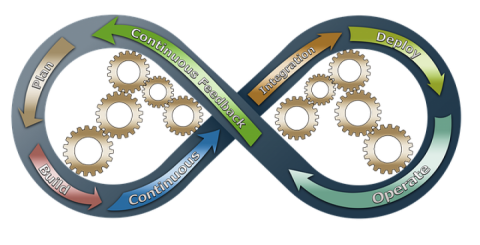Top 10 DevOps Tools To Make Your Life Easy & Work Effortless

DevOps offers a variety of tools and technologies to design, deploy, and test applications in a matter of minutes, with just a few clicks. You can tailor them to client needs and terminate them when not in use. They make processes quick and cost-effective for both the ops team and the development team. Several DevOps tools are making collaboration easy and work effortlessly.
A company that is looking to accelerate production time, improve communication, and reduce cost, must try these ten best tools:
- Ansible: The absolute favorite of almost every company, Ansible, tops this list for a reason. This open-source tool is easy to use and efficient at handling highly complex deployments with simple syntax. It does not hog on your resources and it’s perfect for pushing new changes. Ideal for automating software provisioning, it lowers your infrastructure cost of configuring newly deployed machines and applications. It is also famous for its ability to accelerate the replication speed of scalability. All in all, Ansible is a win-win in terms of cost-effectiveness and time-efficiency. NASA uses it!
- Apache Maven: Highly preferred for automating the build process in Java projects, it is a popular project management tool. Drawing inspiration from the project object model, it uses predefined targets for executing everyday tasks and resolutions. Apache Maven uses XML and most of its features and functionalities come through plugins. The best part - Maven uses convention and not configuration, which means only practical and realistic default values. So, if you’re still using Apache Ant, it’s time you upgrade to Maven!
- Chef: Yet another powerful open-source configuration tool that empowers you to transform your infrastructure into a clean code for efficient management of data, roles, attributes, and more. Compatible with multiple platforms, Chef is easy to integrate with cloud-based frameworks. Irrespective of the size and scope of your IT infrastructure, Chef can automate configurations and app deployments across your networks.
- Docker: This Linux-based platform is portable, secure, and compatible with any language. It focuses on containers, which means you can ship the software & its dependencies in a single package. Docker seamlessly integrates with several tools like Ansible, Jenkins and Bamboo. This open-source enterprise container platform works as a unit to eliminate the hassle of managing dependencies separately. However, this does not mean that you can avoid the cons of poorly architected services with Docker - it all starts with your team!
- Git: Git is another popular open-source platform highly preferred by industry giants like Microsoft, Facebook, and Amazon. It keeps you on top of your development progress and facilitates coordination among team members. Git is great for those who want to experiment as it allows you to revert previously saved versions. You can also create separate branches using Git and add functionalities when the components are ready. However, it is necessary to host a repository such as GitHub for all the work done.
- Puppet: This open-source tool lets you automate software inspection, operation, and delivery. With a solid track record in small projects, it has thousands of modules. It is easy to integrate with multiple platforms. Its free version is an ideal choice for a company with smaller projects. But, if you are managing more extensive projects, consider upgrading to Puppet Enterprise. It lets you handle thousands of resources and manage multiple teams with absolute ease and efficiency.
- Jenkins: Jenkins focuses on the CI/CD pipeline, and it is considered the gold standard for robust deployment automation. Being an open-source automation server, it can be used for reliable configuration management, app deployments, and CI/CD pipelines. Depending on your architecture, toolchain & team structure, you can use a combination of Jenkins, Ansible, and Chef for IT orchestration. A company that wants to ensure greater workflow transparency can use this combination for task automation and app deployment.
- Nagios: Perfect for finding and fixing errors in networks and infrastructure, Nagios is one of the best open-source monitoring tools. Nagios is available in two different editions - Nagios Core and Nagios XI. While both are free, the latter includes more features for a company looking for greater functionality with forum support. You can use it for monitoring apps, network protocols, services & more. It also lets you keep a record of outages and failures.
- Sentry: This free tool comes with inbuilt SDKs and supports JavaScript, IOS, Ruby, and more. It can be customized for compatibility with most languages and platforms. It can continuously monitor scan lines and send notifications in case there is an error in the code. This makes the tool one of the best tools for detecting bugs and problems. Sentry goes the extra mile by not only finding errors but also recommending possible solutions that can be executed with a single click. Microsoft and Uber use Sentry for spotting and rectifying mistakes.
- Splunk: Splunk is a highly innovative tool for a company that wants to boost efficiency and productivity. It makes logs and machine data easily accessible and usable for everyone on your team. Splunk can accurately analyze and visualize much information to facilitate data-driven decisions. Developers can custom tailor Splunk applications and integrate their data into other apps. No wonder Splunk has won several awards apart from making it to the Forbes Digital 100 list.
Whether you choose Ansible, Docker, or Jenkins as your IT orchestration tool, your choice should ultimately depend on your architecture. It is what the project goals you want to achieve. Business enterprises looking to augment and improve their delivery processes can benefit by partnering with a DevOps development company. It helps transform traditional technologies into solution accelerators that facilitate quick collaboration and easy development.
Similar Articles
Decentralized Finance (DeFi) has transformed how users earn passive income through blockchain-based financial systems. Among its most popular use cases,
Staying organized can feel like a full-time job. Between meetings, deadlines, and personal commitments, it’s easy to get overwhelmed.
Choosing the right GIS mapping software depends on what you need to accomplish. Some platforms cater to developers who want to build custom applications from scratch.
For data intensive industries such as insurance, the global business landscape is undergoing a profound transformation. Thanks to all the relentless technological innovation, this shift presents both significant challenges and unparalleled opportunities for modernization of the insurance sector.
Organizations are always looking for newer technologies to aid their operations. So, this hunt revolves around solutions that offer not only agility and scalability but are also cost-effective.
Not long ago, the idea of multiple AI agents working together, each with a specific role, collaborating to solve problems, felt like science fiction.
In today’s data-driven world, choosing the right business intelligence (BI) platform can make or break your organization's analytics success.
We all know that companies today are no longer limited to a single physical location. Work processes are also no longer strictly isolated.
It is neither secret nor news that the mind-boggling pace of digital transformation around us has totally altered consumer expectations.









